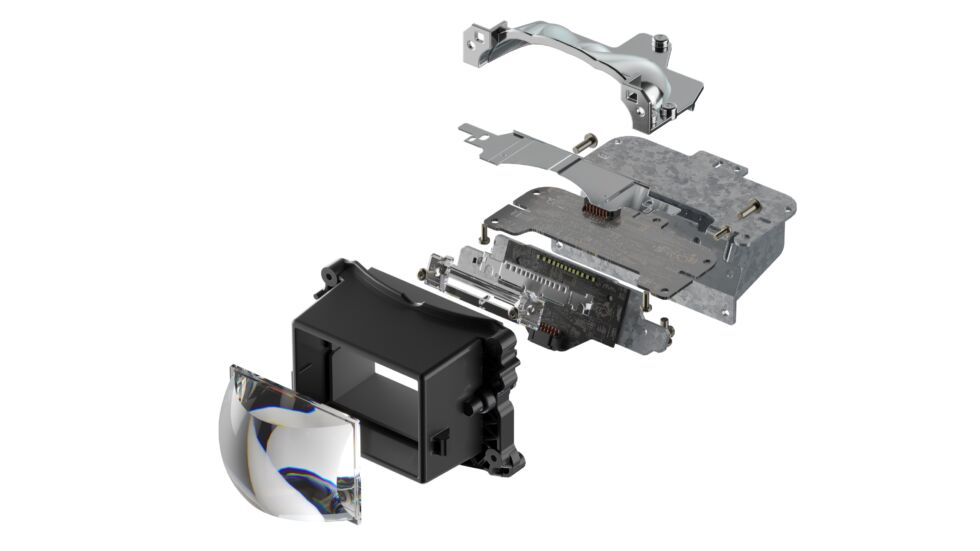
Getty Images
Magna provided flights from Washington, DC, to Detroit and accommodation so Ars could attend its tech day. Ars does not accept paid editorial content.
TROY, Mich.—Despite US dominance in so many different areas of technology, we’re sadly somewhat of a backwater when it comes to car headlamps. It’s been this way for many decades, a result of restrictive federal vehicle regulations that get updated rarely. The latest lights to try to work their way through red tape and onto the road are active-matrix LED lamps, which can shape their beams to avoid blinding oncoming drivers.
From the 1960s, Federal Motor Vehicle Safety Standards allowed for only sealed high- and low-beam headlamps, and as a result, automakers like Mercedes-Benz would sell cars with less capable lighting in North America than it offered to European customers.
A decade ago, this was still the case. In 2014, Audi tried unsuccessfully to bring its new laser high-beam technology to US roads. Developed in the racing crucible that is the 24 Hours of Le Mans, the laser lights illuminate much farther down the road than the high beams of the time, but in this case, the lighting tech had to satisfy both the National Highway Traffic Safety Administration and the Food and Drug Administration, which has regulatory oversight for any laser products.
The good news is that by 2019, laser high beams were finally an available option on US roads, albeit once the power got turned down to reduce their range.
NHTSA’s opposition to advanced lighting tech is not entirely misplaced. Obviously, being able to see far down the road at night is a good thing for a driver. On the other hand, being dazzled or blinded by the bright headlights of an approaching driver is categorically not a good thing. Nor is losing your night vision to the glare of a car (it’s always a pickup) behind you with too-bright lights that fill your mirrors.
This is where active-matrix LED high beams come in, which use clusters of controllable LED pixels. Think of it like a more advanced version of the “auto high beam” function found on many newer cars, which uses a car’s forward-looking sensors to know when to dim the lights and when to leave the high beams on.
Here, sensor data is used much more granularly. Instead of turning off the entire high beam, the car only turns off individual pixels, so the roadway is still illuminated, but a car a few hundred feet up the road won’t be.
Rather than design entirely new headlight clusters for the US, most OEMs’ solution was to offer the hardware here but disable the beam-shaping function—easy to do when it’s just software. But in 2022, NHTSA relented—nine years after Toyota first asked the regulator to reconsider its stance.
Satisfying a regulator’s glare
There was a catch, though. Although this was by now an established technology with European, Chinese, and Society of Automobile Engineers standards, NHTSA wanted something different enough that an entirely new testing regime was necessary to satisfy it so that these new-fangled lights wouldn’t dazzle anyone else.
That testing takes time to perform, analyze, and then get approved, but that process is happening at suppliers across the industry. For example, at its recent tech day, the tier 1 supplier (and contract car manufacturer) Magna showed Ars its new Invision Adaptive Driving Beam family of light projectors, which it developed in a range of resolutions, including a 48-pixel version (with 22 beam segments) for entry-level vehicles.
“The key thing with this regulation is that transition zone between the dark and the light section needs to be within one degree. We’ve met that and exceeded it. So we’re very happy with our design,” said Rafat Mohammad, R&D supervisor at Magna. The beam’s shape, projected onto a screen in front of us, was reminiscent of the profile of the UFO on that poster from Mulder’s office in The X-Files.
“It’s directed towards a certain OEM that likes it that way, and that’s our solution. We have a uniqueness in our particular projector because the lower section of our projector, which is 15 LEDs, we have individual control for those LEDs,” Mohammad said. These have to be tuned to work with the car’s low beam lights—which remain a legal requirement—to prevent the low beams from illuminating areas that are supposed to remain dark.

Magna
At the high end, Magna has developed a cluster with 16K resolution, which enables various new features like using the lights to project directions directly onto the roadway or to communicate with other road users—a car could project a zebra crossing in front of it when it has stopped for a pedestrian, for example. “It’s really a feature-based projector based on whatever the OEM wants, and that can be programmed into their suite whenever they want to program,” Mohammad said.
As for when the lights will start brightening up the roads at night, Magna says it’s a few months from finishing the validation process, at which point they’re ready for an OEM. And Magna is just one of a number of suppliers of advanced lighting to the industry. So another couple of years should do it.
